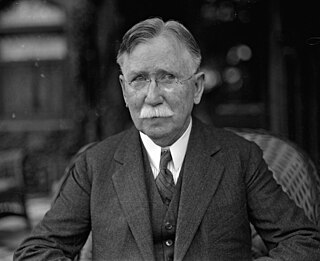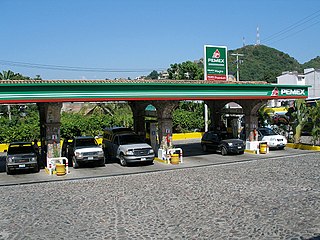
The history of the petroleum industry in the United States goes back to the early 19th century, although the indigenous peoples, like many ancient societies, have used petroleum seeps since prehistoric times; where found, these seeps signaled the growth of the industry from the earliest discoveries to the more recent.

Amoco is a brand of fuel stations operating in the United States and owned by British conglomerate BP since 1998. The Amoco Corporation was an American chemical and oil company, founded by Standard Oil Company in 1889 around a refinery in Whiting, Indiana, and was officially the Standard Oil Company of Indiana until 1985. Originally part of the Standard Oil Company trust, it focused on producing gasoline for the new automobile market. In 1911, as part of the break-up of the Standard Oil trust, it became an independent corporation. Incorporated in Indiana, it was headquartered in Chicago, and formally adopted the name Amoco in 1985. Although the Amoco Corporation merged in 1998 into BP Amoco, the Amoco name was resurrected in 2017 as a brand that service station owners could choose to use when they purchased supplies from BP in selected areas of the United States.

The Teapot Dome scandal was a bribery scandal involving the administration of United States President Warren G. Harding from 1921 to 1923. Secretary of the Interior Albert Bacon Fall had leased Navy petroleum reserves at Teapot Dome in Wyoming, as well as two locations in California, to private oil companies at low rates without competitive bidding. The leases were the subject of an investigation by Senator Thomas J. Walsh. Convicted of accepting bribes from the oil companies, Fall became the first presidential cabinet member to go to prison, but no one was convicted of paying the bribes.
Union Oil Company of California, and its holding company Unocal Corporation, together known as Unocal was a major petroleum explorer and marketer in the late 19th century, through the 20th century, and into the early 21st century. It was headquartered in El Segundo, California, United States.

Chevron Corporation is an American multinational energy corporation predominantly specializing in oil and gas. The second-largest direct descendant of Standard Oil, and originally known as the Standard Oil Company of California, it is headquartered in San Ramon, California, and active in more than 180 countries. Within oil and gas, Chevron is vertically integrated and is involved in hydrocarbon exploration, production, refining, marketing and transport, chemicals manufacturing and sales, and power generation.

The petroleum industry, also known as the oil industry or the oil patch, includes the global processes of exploration, extraction, refining, transportation, and marketing of petroleum products. The largest volume products of the industry are fuel oil and gasoline (petrol). Petroleum is also the raw material for many chemical products, including pharmaceuticals, solvents, fertilizers, pesticides, synthetic fragrances, and plastics. The industry is usually divided into three major components: upstream, midstream, and downstream. Upstream regards exploration and extraction of crude oil, midstream encompasses transportation and storage of crude, and downstream concerns refining crude oil into various end products.

Marathon Petroleum Corporation is an American petroleum refining, marketing, and transportation company headquartered in Findlay, Ohio. The company was a wholly owned subsidiary of Marathon Oil until a corporate spin-off in 2011.

Edward Laurence Doheny was an American oil tycoon who, in 1892, drilled the first successful oil well in the Los Angeles City Oil Field. His success set off a petroleum boom in Southern California, and made him a fortune when, in 1902, he sold his properties.

Pennzoil is an American motor oil brand currently owned by Shell plc. The former Pennzoil Company had been established in 1913 in Pennsylvania, being active in business as an independent firm until it was acquired by Shell in 2002, becoming a brand of the conglomerate.

While the local use of oil goes back many centuries, the modern petroleum industry along with its outputs and modern applications are of a recent origin. Petroleum's status as a key component of politics, society, and technology has its roots in the coal and kerosene industry of the late 19th century. One of the earliest instances of this is the refining of paraffin from crude oil. Abraham Gesner developed a process to refine a liquid fuel from coal, bitumen and oil shale; it burned more cleanly and was cheaper than whale oil. James Young in 1847 noticed a natural petroleum seepage when he distilled a light thin oil suitable for use as lamp oil, at the same time obtaining a thicker oil suitable for lubricating machinery. The world's first refineries and modern oil wells were established in the mid-19th century. While petroleum industries developed in several countries during the nineteenth century, the two giants were the United States and the Russian Empire, specifically that part of it that today forms the territory of independent Azerbaijan. Together, these two countries produced 97% of the world's oil over the course of the nineteenth century.

Juan Pablo Pérez Alfonzo, was a prominent Venezuelan diplomat, politician and lawyer primarily responsible for the inception and creation of OPEC, along with Saudi Arabian minister Abdullah Tariki.

An oil tanker, also known as a petroleum tanker, is a ship designed for the bulk transport of oil or its products. There are two basic types of oil tankers: crude tankers and product tankers. Crude tankers move large quantities of unrefined crude oil from its point of extraction to refineries. Product tankers, generally much smaller, are designed to move refined products from refineries to points near consuming markets.

The petroleum industry in Mexico makes Mexico the eleventh largest producer of oil in the world and the thirteenth largest in terms of net exports. Mexico has the seventeenth largest oil reserves in the world, and it is the fourth largest oil producer in the Western Hemisphere behind the United States, Canada and Venezuela. Mexico is a member of OPEC+ and the North American Free Trade Agreement.
Cerro Azul is a city in the Mexican state of Veracruz. Located in the state's Huasteca Baja region, it serves as the municipal seat for the surrounding municipality of the same name.

Chester Place was one of the first gated communities in Los Angeles, California. It was notable for its close proximity to the University of Southern California, as well as prestigious residents such as Edward L. Doheny. The community later became a satellite campus of Mount St. Mary's College in 1962 after the land was left as a gift from Estelle Doheny.
Compañía Mexicana de Petróleo El Águila SA, (El Águila for short, called in English the Mexican Eagle Oil Company or Mexican Eagle Petroleum Corporation, was a Mexican oil company in the 20th century. The company, established in 1909, produced and commercialised gasoline and lubricants until it was absorbed by the Royal Dutch Shell in 1959.

The history of oil production in California began in the late 19th century. In 1903, California became the leading oil-producing state in the US, and traded the number one position back-and forth with Oklahoma through the year 1930. As of 2022, California produced 3% of the crude oil of the nation, behind Texas, New Mexico, North Dakota, Alaska, Colorado, and Oklahoma. In the past century, California's oil industry grew to become the state's number one GDP export and one of the most profitable industries in the region. The history of oil in the state of California, however, dates back much earlier than the 19th century. For thousands of years prior to European settlement in America, Native Americans in the California territory excavated oil seeps. By the mid-19th century, American geologists discovered the vast oil reserves in California and began mass drilling in the Western Territory. While California's production of excavated oil increased significantly during the early 20th century, the accelerated drilling resulted in an overproduction of the commodity, and the federal government unsuccessfully made several attempts to regulate the oil market.
The Barco oil concession was one of the main concessions in Colombia during the early development of its petroleum industry, the other being the De Mares concession. Oil was first found in the Norte de Santander department near the border with Venezuela in 1905, but development did not start until 1936. A joint venture between the Texas Corporation and Socony-Vacuum sank the wells and built a 263-mile (423 km) pipeline across the mountains and through swampy jungle to the Caribbean coast at Coveñas. Workers were harassed by Motilone Indians defending their territory, and several died. The concession began operation in 1939 and continued into the 1960s, when it began to be depleted. Other fields in the region are still productive.
Lago Petroleum Corporation was an oil production company established by Americans in 1923 that exploited the oilfields in Lake Maracaibo. It was acquired by Standard Oil of New Jersey in 1932. Later it was nationalized.

The California oil and gas industry has been a major economic and cultural component of the US state of California for over a century. Oil production was a minor factor in the 19th century, with kerosene replacing whale oil and lubricants becoming essential to the machine age. Oil became a major California industry in the 20th century with the discovery on new fields around Los Angeles and the San Joaquin Valley, and the dramatic increase in demand for gasoline to fuel automobiles and trucks. In 1900 California pumped 4 million barrels (640,000 m3), nearly 5% of the national supply. Then came a series of major discoveries, and the state pumped 100 million bbl (16 million m3) in 1914, or 38% of the national supply. In 2012 California produced 197 million bbl (31 million m3) of crude oil, out of the total 2,375 million bbl (378 million m3) of oil produced in the US, representing 8.3% of national production. California drilling operations and oil production are concentrated primarily in Kern County, San Joaquin Valley and the Los Angeles basin.

















